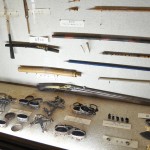Archive for April, 2013
Tuesday, April 30th, 2013
I had a lot of questions on my last post on Emergency medical preparations, especially in regards to what would you do if you had to treat basic wounds and you were living off the land or behind enemy lines. Well, the ancient(and modern) ninjutsu practitioners were(and should be) very familiar with herbal or traditional medicine. From the Shindenfudu ryu we learn to be and train in nature, so why would one not learn to utilize all that is around them as part of the personal protection training? I am not going to give you a list of herbs and cures(more on this is coming in the updates next month in the Online Training Center) , but here are a few simple and common plants that you should learn to identify and use in treating superficial cuts and scratches:
Comfrey: Comfrey salves, ointments and teas are best known for the topical treatment of burns and just about any skin irritation.
Goldenseal: Goldenseal is a folk medicine staple widely used in many herbal salves and ointments as a contact disinfectant.
Plantain: The macerated fresh plantain leaves are put on bee stings and used for skin irritations, malignant ulcers,and burns, and to stop bleeding in minor cuts.
I have only listed three basic plants here that are quite common and each can be utilized to help clean and treat minor cuts, burns and scratches. For your homework research 2 additional plants native to your area that you can use to help treat minor wounds or burns.
Bufu Ikkan!
Sunday, April 21st, 2013
 In ancient times, the ninja had to understand and be able to treat common injuries from training and or from warfare, as well as be able to treat themselves or others for diseases. Today, we have the luxury of driving to the doctor’s or calling 911 for an emergency, but what if you couldn’t call or get to where medical treatment could be applied? As one of the 13 skills I chose to improve upon this year, Emergency medical treatment was one of them. Over the years I have been involved as a first responder for hazardous emergencies through the various jobs that I have held, but much earlier in my life I began gaining a basic understanding of traditional methods for healing soft tissue injuries, acupressure, and medicinal herbs. More recently I have continued on by attending various first aid, and tactical medical courses. I also have several first aid kits that I carry on backpacking trips, in my vehicle, work, dojo etc. All with the underlying belief that it is better to be prepared than not to be when the time comes. Has this paid off? Yes, I have assisted at car accidents, seizures, lacerations, broken bones and CPR events. In ancient times, the ninja had to understand and be able to treat common injuries from training and or from warfare, as well as be able to treat themselves or others for diseases. Today, we have the luxury of driving to the doctor’s or calling 911 for an emergency, but what if you couldn’t call or get to where medical treatment could be applied? As one of the 13 skills I chose to improve upon this year, Emergency medical treatment was one of them. Over the years I have been involved as a first responder for hazardous emergencies through the various jobs that I have held, but much earlier in my life I began gaining a basic understanding of traditional methods for healing soft tissue injuries, acupressure, and medicinal herbs. More recently I have continued on by attending various first aid, and tactical medical courses. I also have several first aid kits that I carry on backpacking trips, in my vehicle, work, dojo etc. All with the underlying belief that it is better to be prepared than not to be when the time comes. Has this paid off? Yes, I have assisted at car accidents, seizures, lacerations, broken bones and CPR events.
As a part of your training, I would like you to do the following:
1) Take a basic CPR/First aid course
2) Prepare a travel and a home emergency first aid kit (Notes will be up in the Online training section on what your kits should contain.)
3) Gain knowledge on soft tissue recuperative techniques
These three points will help lead you down a path of Ninja preparedness that could save you or your loved ones life someday. Not to mention that basic healing techniques after training go a long way in a speedy recovery!
Alright now go out and train!
Bufu Ikkan
PS: A new revamping of our Online training sections is underway and more information on Ninja Medical remedies will be available soon!
Thursday, April 18th, 2013
Hello Ninjutsu Fans,
Stories of my untimely death at the hands of a rogue Ninja clan are sadly untrue! Actually, I took some time off for family and training reasons but now I am back with a lot of new material coming your way! I receive a lot of emails from practitioners around the world and the following is a great topic for us all to think about.
“Sensei, you write that Bajutsu (Horsemanship) was a part of the Ninja Juhakkei, how would you interpret this in a modern application.” (Mark K. Utah)
Let’s start first that Bajutsu (horsemanship) was a “mandatory” discipline for the bushi warriors especially starting from the Edo period, bajutsu is the art of fighting while riding, being able to both lead the horse and make a proper use of the kyu (archery), naginata, yari or sword. Now although you can still get around on a horse, it is clearly not efficient or the mode of transportation that you will most encounter. So, let’s take a big picture first ; most likely you will be utilizing a vehicle such as a car, truck, or even a motorcycle in your daily commute, so on a first level you should be aware and knowledgeable about how to drive the two types of vehicles standard and automatic transmission, as well as how this is adapted to a motorcycle. Next, have you familiarized yourself with 2 wheel, 4 wheel, rear wheel and front wheel driven vehicles? There is still a lot of material just with this gross level understanding of transportation and then what about learning how to fix and maintain the vehicles, and how to utilize it as a weapon? Then of course can you utilize a modern weapon from a moving platform? No this isn’t your gang banger drive by, but serious thought and practice should be place on deploying your everyday carry weapons from a seated, seat belted and moving position. Hey have you even thought about the defensive applications and strong and weak points of your vehicles structure? Not to make light of this subject matter but can you ride a horse, bicycle, do you know the local train schedule, start and or move an 18 wheeler? Bajutsu may have been about horses in the past but the modern application of this strategy would be to encompass all modes of transportation. Hey don’t even get me started on airplanes or helicopters!!(LOL)
Bufu Ikkan
Thursday, April 4th, 2013
Hidden Weapon Skills/Concealed Weapon Skills
 One thing that drew me to ninjutsu was the variety of hand held and often deceptive looking items that were actually deadly weapons. Weapons such as: Shuko/Ashiko, Tetsubishi/Makibushi, Kakute, Tegiribo, Kakushibo, Konpi/Konpei, Shuriken, Fukiya, Nekode, have fascinated me since I was a young boy. But, how do we utilize these ancient weapons in today’s modern world? One thing that drew me to ninjutsu was the variety of hand held and often deceptive looking items that were actually deadly weapons. Weapons such as: Shuko/Ashiko, Tetsubishi/Makibushi, Kakute, Tegiribo, Kakushibo, Konpi/Konpei, Shuriken, Fukiya, Nekode, have fascinated me since I was a young boy. But, how do we utilize these ancient weapons in today’s modern world?
Well of course we interpret and adapt! By this I mean utilizing the principles of concealed weapons in a modern “legal” manner. Here is an example for you, metsubishi (sight remover) was a common tactic of the Togakure ryu ninja. They would hollow out an egg and then replace the contents with a combination of ash, nettles, and various items that when thrown into an opponent’s eyes would remove or hinder their sight. In today’s world it is easy to get your hands on a container of “tear gas” that you can carry in most states legally. They come in a variety of forms, from simple hand held containers to crowd and room clearing agents. But, let’s say you are traveling to Canada, or on a plane, you cannot legally carry an item such as this on your person, but what about that small container of cayenne pepper that you “love” to put on your food…J well of course it is legal, although strange to see someone carrying this but thrown into someone’s eyes it is as effective as most store bought tear gas.
So my ninja’s in training that is just one method to take an ancient strategy and apply it in the modern world.
Bufu Ikkan
|
|


